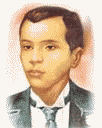The tragic fight of Andres Bonifacio
Who was Andres Bonifacio and what was his contribution to the Philippine movement of independence? Childhood and youth Born in 1863, Bonifacio grow up in Tondo (Manila) under poor slum-conditions. So far, he has unquestionably the worse starting conditions compared with such of Rizal or Aguinaldo. The father was a boatman carried later heavy loads, the mother, a Mestiza, was busy as forewoman in a cigarette factory. Andrea Bonifacio still had two sisters and three brothers, which fought later at the side of his brother. Andres visits only a elementary school. In the following time he continues his studies as an autodidact. In 1880 his mother dies of tuberculosis, a year later the father of the same illness. Andres Bonifacio is now 18 years old and must provide the family. He is first a running boy and street vendor, later an office clerk and sales agent for an English company. It follows the German employer Carlos Fressel & Company. Here he works as a supply clerk and sales agent. His first wife passes away early on leprosy. Young son Andres from second marriage dies of smallpox. In his leisure time Bonifacio reads among other books the novels of Rizal - he taught himself the Spanish language. Books open him new perspectives and confirm him in his decisive antagonism to the Spanish colonial system. "The spark of rebellion jumps over" (1). The enthusiastic nationalist joins Rizal´s "Liga Filipina" and he meets also the admired Rizal. The foundation of the Katipunan secret society The "Liga Filipina", which expects peaceful reform steps of the Spanish colonial power can't get an image and remains ineffective, however. It gets dissolved after Rizal´s banishment. Together with other dissatisfied friends Bonifacio forms the secret society of Katipunan and becomes its president ("Supremo") one year later in 1983. The Katipunan - or "KKK", which means in English "High and Respectable Union of the Sons of the Nation" operates as an alternative Filipino government and has three basic principles:
In 1896 the Spaniards gain the information, that the secret movement has round about 30.000 members in and around Manila. Unlike the Liga Filipina, which represented more a circle of intellectuals and wealthy ones, the Katipunan was a people movement that recruited itself mainly from farmers, small traders, craftsmen and workers. Bonifacio would have been delighted to see the charismatic Rizal on the top of the organization. Therefore, he sends in 1896 a friend to the place of banishment of Rizal. Rizal refuses however. Not, because he refuses the revolution in general. He doubts however the military success of an armed revolt and refers to the history of Cuba. Rizal takes the view that the number and quality of weapons and the absence of a military-strategic concept does not yet allow a revolt. In addition he pleads for a stronger integration of the rich and influential circles in the Philippines. Bonifacio is very disappointed about the refusal. In order not to endanger the success of the revolution, Bonifacio suppresses the further-spread of the refusal. Bonifacios fights With help of the spy-network of Spanish monks the Spanish rulers got information about the dangerous underground movement. When the first arrests occur, Bonifacio believes, that four years after the foundation - the time for attacking has come. However, his troops have only a bad equipment. They have only bolos (long knives) and old rifles. In August 1896 there is the "Cry of Balintawak". Under the calls of "Long live the Philippines" residence tax papers are torn up in order to make obvious the break with the Spanish authorities. Simultaneously they swear to fight against the Spaniards down to the last man. With eight hundred men they approach an ammunition depot in San Juan, but they cannot conquer the depot. The following weeks show further fights, which frequently end with heavy losses of the Katipuneros due to the arm-technical inferiority. Now it becomes evident that Bonifacio is not a military strategist. "The fury that stimulated Bonifacio did not suffice, in order to provoke a revolution" (3) . The Spaniards pursue the withdrawing troops of Bonifacio. Now under the Spanish governor-general Blanco mass arrests, confiscation of properties and executions without legal hearing are under the agenda. The appearance of Emilio Aguinaldo
Now on Cavite arguments blow up between Catipuneros which support Bonifacio respectively Aguinaldo. The conflict escalates, there are no mutual supports anymore. The Spaniards reconquer parts of the country. Bonifacio is ready to go to Cavite in order to settle the dispute. Aguinaldo has more long-range plans. While Bonifacio insists on the old structure of the Katipunan, Aguinaldo prefers a government structure following the American model. A meeting in Tejeros is arranged and they agree, that the decisions of the majority should be strictly binding. The meeting at Tejeros The elections show a surprising result. The majority of the Katipuneros elects Aguinaldo as president of the declared republic. Bonifacio is only nominated for the position of director of the interior. Simultaneously there are doubts if he has as a non-lawyer the necessary qualifications for this position. Bonifacio feels offended and bitterly disappointed. He doubts the correctness of the elections procedures and he believes that he could annul the decisions and voting of the meeting. One day later the absent Aguinaldo takes his oath of office. Bonifacio does not accept the new government under Aguinaldo and installs a rival-government. Condemnation and execution As countermeasure the government under Aguinaldo orders the arrest at Bonifacio in Limbon. His house gets surrounded. In the following combat his brother is killed and Bonifacio is shot into the arm. Strongly weakened and half starved he is brought on a stretcher to Naik. Here he is taken to a court. Bonifacio is accused of the betrayal of the revolution and of trying to poison Aguinaldo. Bonifacio has hardly rights of self-defense and is condemned to death like his brother Procopio. President Aguinaldo first hesitates to give the order of execution. He prefers a banishment of Bonifacio. However, his generals press him, not to show no pity and to go on with the execution in order to maintain the peace and the order within the new revolutionary government. A squadron gets the order of execution. Bonifacio sees his end and falls on his knees asking for mercy. Trying to escape he and his brother are dying in a bullet-hail. With bayonets the bodies are buried hastily. Andreas Bonifacio became only 34 years old. "Thus ended the stormy life-career of this great Filipino, this dynamic plebeian, our man of action", the historian A.M. Molina (4) is formulating. 1918 the mortal remains are exhumed after a longer search. The urn is transferred into the Legislative Building (today National Museum). In the fire storm of the battle of Manila in 1945 the building is totally destroyed and the remains were lost. Appreciation of Achievements While the American colonial-power understandably ignored the figure of Bonifacio, he is especially for the left-wing orientated persons and institutions nearly a mythical, great plebeian hero of the history of the Philippines. There are monuments and pictures on stamps and bills which honour him. Nevertheless he does not get an adequate appreciation. The causes for ignorance can be a lack of personal documents or the public shame, because Bonifacio was killed by his own compatriots. Ed Aurelio Reyes (5) formulated in 1994 the following provocating remark: "Bonifacios body was killed on 10th May, 97 years ago. But his stature, his memory and his spirit have all been killed again and again by our nation due to widespread ignorance and apathy". Also the known historians T. A. Agoncillo and M.C. Requiring Guerrero are insisting: "Bonifacio should be placed side by side with Rizal in so far as the national estimation is concerned (2). © Wolfgang Bethge, 2003 ------------------------------------------------------------------------------------------------------
|
 In 1997 the Philippines celebrated the centennial jubilee of the proclamation of independence from the Spanish colonial system. The historical figures of Rizal and the president of the first republic Emilio Aguinaldo stood rightly in the focus of public attention. But in the shadow of the two there is still another pioneer and protagonist of the Philippine independence movement, whose contribution for the independence historians sometimes belittle or are presenting an opposite point of view: Andres Bonifacio.
In 1997 the Philippines celebrated the centennial jubilee of the proclamation of independence from the Spanish colonial system. The historical figures of Rizal and the president of the first republic Emilio Aguinaldo stood rightly in the focus of public attention. But in the shadow of the two there is still another pioneer and protagonist of the Philippine independence movement, whose contribution for the independence historians sometimes belittle or are presenting an opposite point of view: Andres Bonifacio. The secret society follows the example of secret Masonic lodges, which gained foothold at this time on the Philippines. The Masonic organization includes a strong selection of the members, specific rites of ignition with blood compact, secret passwords and a special communication structure (triangle-system), encoding-systems, colored hoods and flag symbols (2). The Katipunan had later government-similar structures with a president, secretaries of departments, a kind of parliament kind and a court of justice. Thats why some are seeing Bonifacio - not Aguinaldo as the first president of the republic.
The secret society follows the example of secret Masonic lodges, which gained foothold at this time on the Philippines. The Masonic organization includes a strong selection of the members, specific rites of ignition with blood compact, secret passwords and a special communication structure (triangle-system), encoding-systems, colored hoods and flag symbols (2). The Katipunan had later government-similar structures with a president, secretaries of departments, a kind of parliament kind and a court of justice. Thats why some are seeing Bonifacio - not Aguinaldo as the first president of the republic. Emilio Aguinaldo (1869 - 1964), son of a richer farmer and mayor in Cavite, joined in 1894 the Katipunan. First there was a strong friendship with Bonifacio. Unlike Bonifacio, which is abandoned from war fortune, Aguinaldo manages successful fights expelling the Spaniards almost completely from the peninsula of Cavite. Aguinaldo is regarded as a warhorse with higher military leadership-qualities, on the other side he is a clever pragmatist. More and more he becomes the charismatic key figure in the fight against the Spaniards while the formal leader of the Katipunan Bonifacio moves into the background.
Emilio Aguinaldo (1869 - 1964), son of a richer farmer and mayor in Cavite, joined in 1894 the Katipunan. First there was a strong friendship with Bonifacio. Unlike Bonifacio, which is abandoned from war fortune, Aguinaldo manages successful fights expelling the Spaniards almost completely from the peninsula of Cavite. Aguinaldo is regarded as a warhorse with higher military leadership-qualities, on the other side he is a clever pragmatist. More and more he becomes the charismatic key figure in the fight against the Spaniards while the formal leader of the Katipunan Bonifacio moves into the background.